


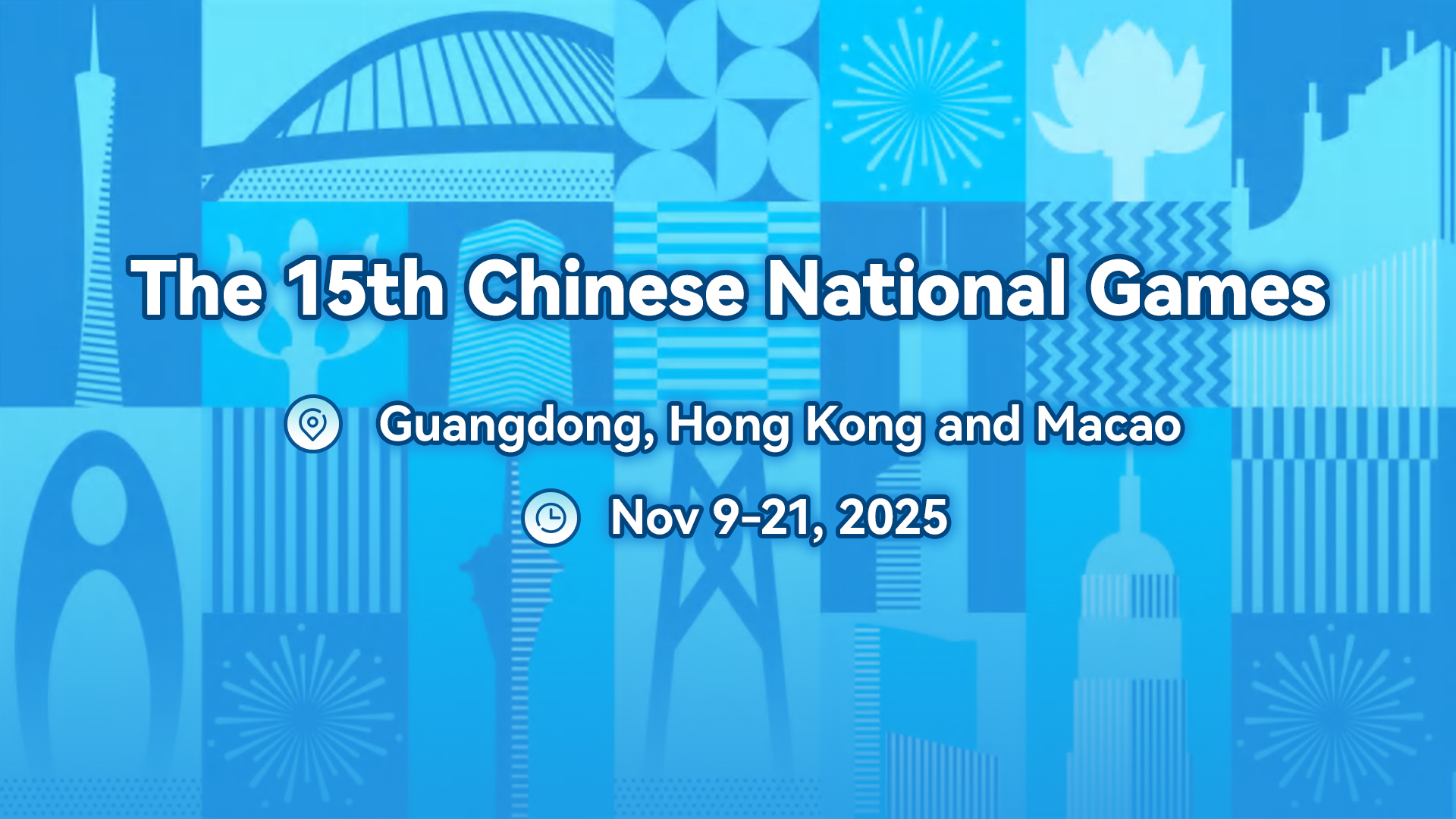
China's 15th National Games will open on Nov 9 across the Guangdong-Hong Kong-Macao Greater Bay Area, marking the first time three regions have co-hosted the country's premier multi-sport event.
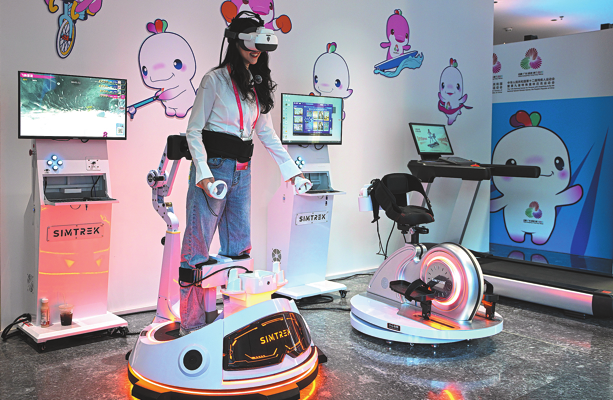
With the deeper integration of technology and sports, athletic enthusiasts are placing great expectations on the technological innovations that will be featured during the upcoming 15th National Games, hoping these innovations will enhance the quality of competitions, create an engaging viewing experience and offer thorough support for the event.
Scheduled to run from Sunday to Nov 21, the games will be jointly hosted by Guangdong province and the Hong Kong and Macao special administrative regions in the Greater Bay Area, a leading tech hub of China, with a strong emphasis on the use of technology.
Spectators will bear witness to emerging technologies. For example, the 3D virtual National Games village will provide audiences with an immersive online interactive experience, and digital volunteers will offer them 24-hour assistance. Additionally, precise indoor positioning technology will help visitors navigate the venues, and AI cameras for specific sports such as badminton will capture key moments in the matches and offer multi-angle viewing options.
Yang Guanrun, a running enthusiast who works in the consulting industry, hailed the arrangements as aligning with international trends, which aim to enhance spectator engagement at major events and create an equally immersive experience for off-site viewers using smart devices such as phones or computers.
Yang called for more domestic sporting events to embrace similar technological measures to help Chinese athletes achieve better results.
A badminton fan surnamed Man said he believes that the AI cameras designed for badminton matches can enhance athletes' skills, while also helping spectators learn techniques and deeply engage in the intense atmosphere of competitive matches.
Man said that even everyday sports have significant potential for technological applications. He hopes to see more innovative technologies used in popular activities, which could be preserved after events for widespread use by enthusiasts so the public can enjoy sports even more.
A sports lover surnamed Liu, who works at a National Games venue in Shenzhen, Guangdong, pays particular attention to the application of assistive technology.
He mentioned that to host the National Games, the venue underwent upgrades to improve accessibility for people with disabilities. Since only a few new venues were built for the event, the role of technology is even more crucial in better serving athletes and spectators with disabilities.
Liu is pleased to see that innovations such as exoskeleton robots, stair-climbing wheelchairs and apps with sign language translation features will be used in the games to assist the disabled. He hopes that new technologies will continue to address the needs of disadvantaged groups.
Swimming enthusiast Ni Meilan emphasizes the accessibility, convenience and safety of technologies leveraged at the games. She hopes that the barriers for viewers who want to experience the technologies will be lowered, allowing groups such as the elderly, who may be less familiar with tech, to also benefit.
She said she also hopes that the use of emerging technologies such as driverless shuttles transporting athletes and spectators will not only reduce the need for manual labor, but also be well-organized to alleviate congestion and minimize passenger wait times. Furthermore, she emphasized the importance of ensuring safety with the implementation of technologies such as autonomous vehicles, drones and robots, aiming to minimize their impact on people's daily lives.
bingcun@chinadailyhk.com
The 15th National Games, jointly hosted by Guangdong province and the Hong Kong and Macao special administrative regions for the first time, are playing a part in accelerating the integrated development of the Guangdong-Hong Kong-Macao Greater Bay Area, organizers of the sports event said.
To ensure the success of the games, which will begin on Sunday and run through Nov 21, relevant authorities will further simplify entry and exit procedures to facilitate the movement of personnel among the three regions.
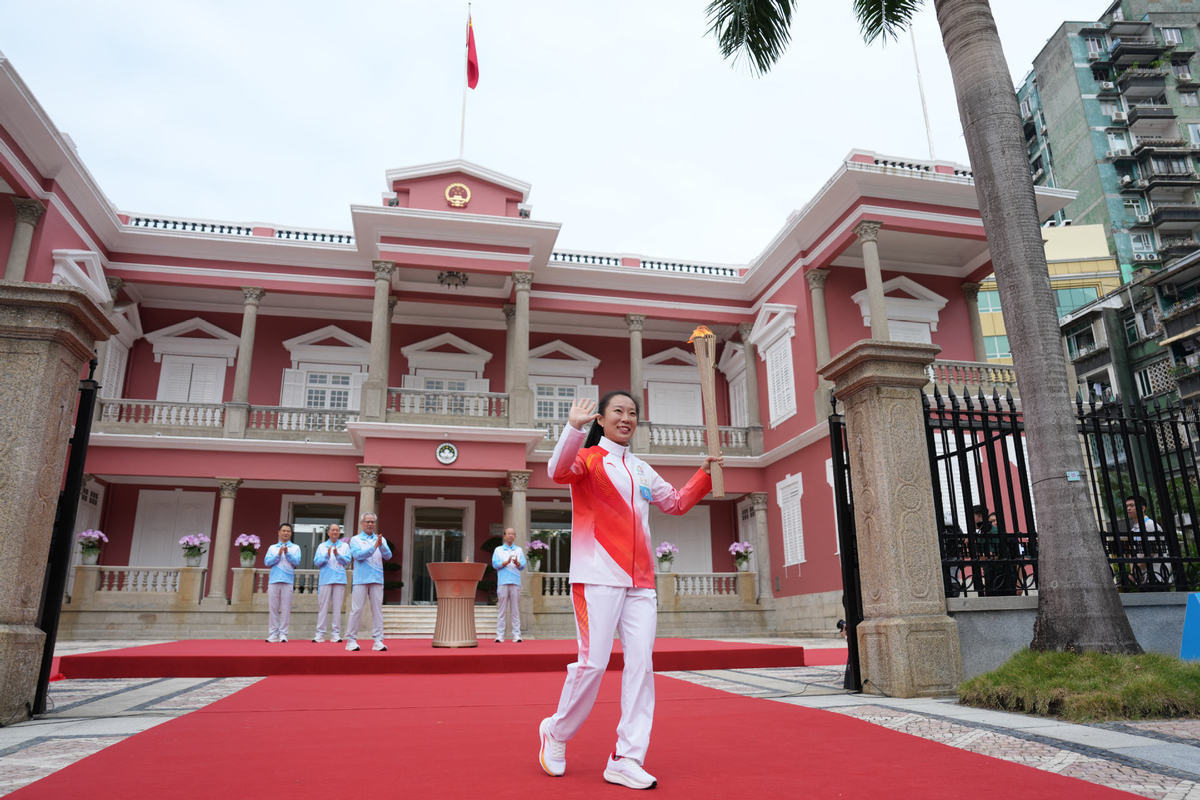
Under the guidance of the General Administration of Sport, the China Disabled Persons' Federation and the Hong Kong and Macao Work Office of the Communist Party of China Central Committee, the regions have reached consensus in six key areas through extensive communication and negotiations — cross-border events, port clearance, personnel and vehicle documents, food safety, green event management and the event schedule, explained Huang Mingzhong, director of the office of the 15th National Games Executive Committee.
"The three regions have explored a joint competition model of 'three regions with three similarities', indicating 'same frequency communication, concerted decision-making and synchronous execution'," said Huang, who is also deputy secretary-general of the Guangdong provincial government.
"Taking the emblem design as an example, our emblem consists of three petals. With Guangdong's kapok, Hong Kong's bauhinia and Macao's lotus overlapping and rotating, it forms a concentric floral pattern, symbolizing the unity and deep integration of the Guangdong-Hong Kong-Macao Greater Bay Area," he said.
Huang noted that one of the games' events, the Guangdong-Hong Kong-Macao road cycling race, will take place in all three regions.
"Cyclists will depart from Zhuhai and first reach Macao via the Macao Bridge, and then arrive at Hong Kong's Lantau Island via the Hong Kong-Zhuhai-Macao Bridge," he said.
Sun Jiaojiao, a senior border inspection officer at the Shenzhen Bay checkpoint in Guangdong, said that for the games' cross-border marathon, the border inspection department has established pre-inspection areas at both ends of the Shenzhen Bay Bridge to enable seamless completion of exit-entry procedures for athletes and personnel who need to cross.
The marathon, with both start and finish lines at Shenzhen Bay Sports Center, will take place on Nov 15. It requires athletes to run across the Shenzhen Bay Bridge to enter Hong Kong, and after turning around, return to the center.
Zhang Zhihua, deputy director of the Hong Kong and Macao Affairs Office of the People's Government of Guangdong Province, said relevant departments have set up a dedicated channel at entry and exit ports, allowing games' delegates to enter and leave whenever they need.
"We have also opened a green channel for our ticket holders, with nationwide application for entry and exit documents," he said.
"With special treatment for entry and exit, we will contribute to the development of a one-hour life circle within the GBA," said Zhang, who is also the deputy director of the coordinating department of the 15th National Games Executive Committee.
During the games, visitors can enter and exit the regions without needing to show documents, he said.
Guangzhou will host the opening ceremony, while Shenzhen will host the closing ceremony.
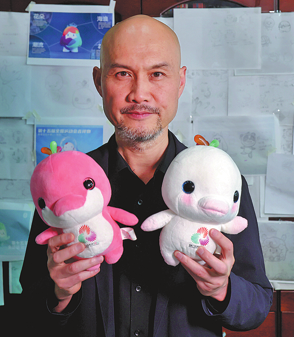
The mascots for the upcoming 15th National Games, Xiyangyang and Lerongrong, are winning hearts online. The team that designed them was led by Liu Pingyun, who sees them as embodying the distinct cultural identities of cohosts Guangdong province and the Hong Kong and Macao special administrative regions, while also symbolizing the region's shared roots and growing integration.
The mascots were inspired by the Chinese white dolphin, a resident of the Pearl River Estuary known as the "giant panda of the sea" and classified as a grade 1 national key protected species.
Xiyangyang's white color reflects the dolphins' natural hue, while Lerongrong's pink skin represents the flush the dolphins exhibit when active, symbolizing the games' spirit of striving for progress.
In the run-up to the games, which are set to open on Sunday, the mascots' cute appearance and resemblance to chickens — popular in Guangdong, Hong Kong and Macao cuisine — have ignited increasingly widespread online discussion.
Internet users have affectionately given them nicknames such as "great bay chicken", "boiled sliced chicken" and "soy sauce chicken". And the mascots have featured in various fan creations, including videos, memes and cultural products, with an enormous estimated commercial value.
Liu noted that while selecting the mascot prototype, his team explored elements linked to the Guangdong-Hong Kong-Macao Greater Bay Area, such as animals, plants and Chinese characters. After experimenting with designs based on the South China tiger, lions from the traditional lion dance and the symbolic Five Rams Statue of Guangdong's capital, Guangzhou, they chose an animal that had never been featured as a National Games mascot.
The dolphins not only exude the cuteness young people love, but also signify China's commitment to ecological civilization.
"Most importantly, this choice fully represents the integration of the three regions," Liu highlighted.
Currently, there are approximately 6,000 Chinese white dolphins worldwide, with 2,000 inhabiting the Pearl River Estuary, which makes it the largest habitat for these dolphins worldwide.
The heads of Xiyangyang and Lerongrong are decorated with three splashes of water in different colors. Liu said that the red represents Guangdong, symbolizing the kapok bloom, the city flower of Guangzhou. The purple stands for Hong Kong, embodied by the bauhinia, while the green signifies Macao, represented by the lotus. These colors are also featured in the emblem designs of the 12th National Games for Persons with Disabilities and the 9th National Special Olympic Games, showcasing a deep understanding of the unique yet harmoniously integrated cultures of the three regions.
This interpretation also mirrors Liu's personal understanding of these regional cultures.
Originally from Jiangxi province, Liu relocated to Guangzhou in 2000 to study for his master's degree, and then to Macao in 2018 to pursue a doctorate. Subsequently working at the school of visual arts design at the Guangzhou Academy of Fine Arts, where he now serves as the dean, he has spearheaded numerous design projects, including the creation of the widely acclaimed Beijing Winter Olympics mascot Bing Dwen Dwen.
Having lived in the region for over two decades, Liu identifies himself as a "typical" Guangzhou resident, actively "experiencing and absorbing" the local culture in his daily life.
In his view, the cultural histories of Guangdong, Hong Kong and Macao each possess unique characteristics. Hong Kong and Macao showcase a vibrant fusion of Eastern and Western cultures. Macao, for example, boasts Portuguese-style stone pavements and an array of unique cuisines.
Despite these distinctions, the three regions share common foundations such as language, the appreciation of Chinese culture and a unique maritime heritage from their locations along the Maritime Silk Road. While preserving their distinctiveness, the regions demonstrate a marvelous integration, embodying the cultural essence of the GBA, Liu said.
He also noted that the regions have shown mutual respect and support throughout the design process, maintaining smooth communication. The design team reports to authorities in each region and has received active feedback.
Liu and his team were caught off guard by the mascots becoming internet sensations. Their popularity was unexpected, but the team is pleasantly surprised, he said.
"Such interpretations by netizens mean that the intellectual property resonates with the public and blends into their daily life," Liu said.
Lesley Liu contributed to this story.
amberwu@chinadailyhk.com
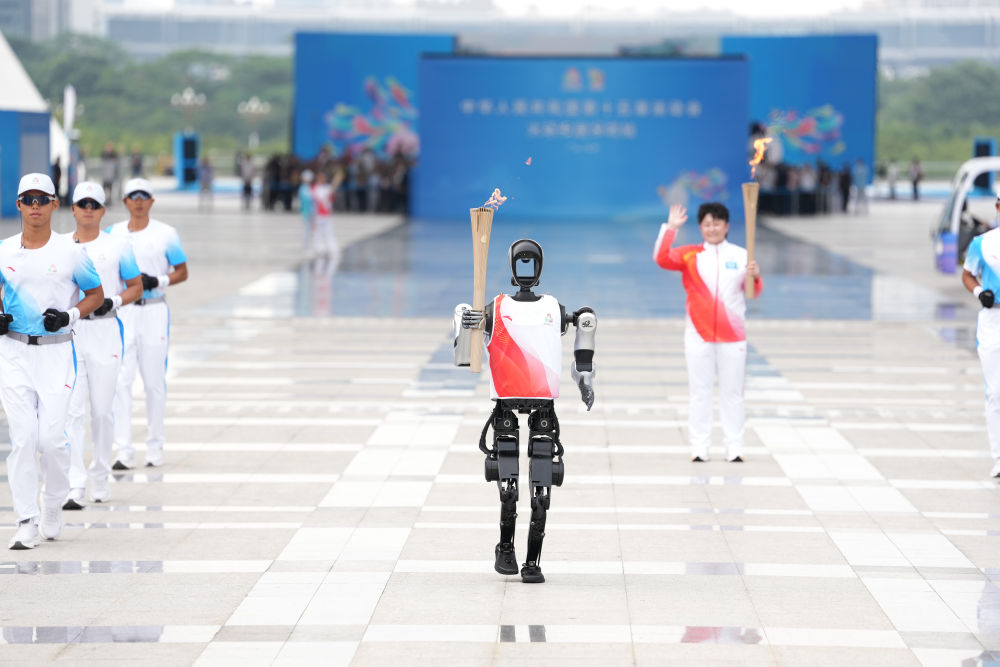
The opening ceremony of the 15th National Games will showcase the time-honored history, profound cultural heritage, openness, inclusiveness and economic vitality of the Lingnan — or southern Chinese — region, directors and producers of the sports event said.
During the artistic performance segment of the ceremony, which will integrate traditional Lingnan culture with cutting-edge technology, lion dances will be blended with virtual reality technology and content generated by artificial intelligence; Yingge dances, drums and gongs will be paired with holographic projections; and racing dragon boats will be "rowed" into the audience through augmented reality technology.
"With joint efforts and unity of all creators and performers, we will try to present a wonderful performance," said Lang Kun, chief director of the opening ceremony.
Wang Ruixiang, chief producer of the event, said every work team is busy refining the details, striving to present a splendid audiovisual feast for audiences across the country on the night of the opening ceremony.
As of Thursday, six general rehearsals had been organized to ensure the opening ceremony's success.
The comprehensive rehearsals have fully evaluated all elements, including the pre-ceremony performances, ritual segments, and cultural and sports presentations.
All rehearsals have proceeded in an orderly and seamlessly-coordinated manner, vividly embodying the principle of hosting a "streamlined, safe and splendid" event while showcasing the unique charm of the games, which are being jointly hosted by Guangdong province and the Hong Kong and Macao special administrative regions for the first time.
The opening ceremony will officially kick off at 8 pm on Sunday in the Guangdong Olympic Sports Center in Guangzhou, the provincial capital.
"We aim not just for stellar performances, but also to make every participant feel the warmth of sports and the affinity of culture," said Andrew Lau Wai-Keung, executive producer of the ceremony.
The opening ceremony has ingeniously integrated iconic landmarks, including Hong Kong's Victoria Harbor, the Ruins of St. Paul's in Macao and Guangzhou's Canton Tower, showcasing the vibrant vitality and connectivity of the Guangdong-Hong Kong-Macao Greater Bay Area.
Meanwhile, aligning with Guangzhou's identity as the "City of Flowers", the creative team has woven the celebration around three core themes: the beauty of technology, the beauty of humanity and the beauty of sport, presenting an opening ceremony that will be a visual spectacle and take viewers on an emotional journey.
University students are planning to put on Lingnan's Early Spring production, which promises to be a stunningly beautiful performance featuring singing, dancing and acting.
Huang Peiling, deputy chief director of the ceremony, said the performers have worked hard to give audiences the impression of "being as one".
Gao Yan, executive director, said the performance is taking a youth-oriented approach, incorporating performances such as ballet, street dance and symphony to resonate with young audiences.
In addition to the well-known traditional elements, including Yueju Opera, Wing Chun and Qilin dance, the opening ceremony stage also served as a vibrant showcase for reinvented cultural symbols drawn from the grassroots. The exquisite patterns of Guangdong embroidery, the radiant shimmer of Canton enamel, and the three-dimensional collage of Chaozhou porcelain cut-out artwork — all of these, through innovative design, are brilliantly reimagined and make a stunning debut.
Qiao Wei, the ceremony's chief contributor, said that the opening ceremony will integrate scattered Lingnan cultural symbols into a "dream-fulfillment" story, showcasing the shared pursuit of a better life among residents of the GBA.
The 15th National Games will take place between Nov 9 and 21.
zhengcaixiong@chinadaily.com.cn
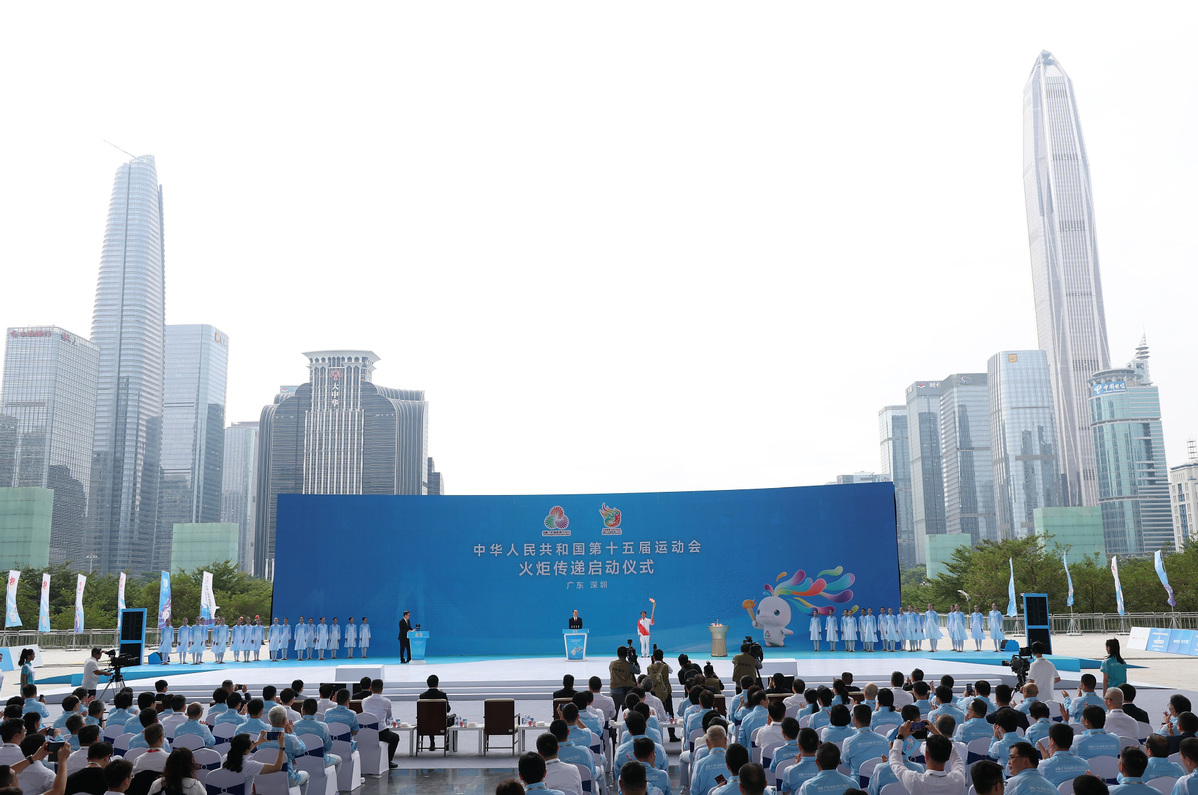
In 1984, few would've expected a county sports meeting held in Zhengding, Hebei province, to have played a tone-setter role, as significant as it seems now, for China's sports development on all fronts in the next four decades and beyond.
Many had even questioned whether it was necessary to host such an event in a rural county like Zhengding at the time, when the whole nation went all out pushing ahead with economic, agricultural and industrial modernization, leaving sports promotion among the least prioritized government agenda items.
As its initiator, President Xi Jinping, who then served as secretary of the Communist Party of China Zhengding county committee, carried it out anyway, hosting 10 sports disciplines on a middle school playground to gather over 1,300 participants of all ages, according to a Xinhua documentary.
The county was left abuzz and its residents were excited, while Xi got his ideas across.
People's fitness and mental health, benefited by taking part in sports exercise, would contribute to the overall well-being and solidarity of the nation, Xi's former colleagues said as they recalled his farsighted vision embodied by putting together the county games against the odds.
"Many would not understand such a decision back then," Cheng Baohuai, then county head of Zhengding, said in the documentary released in August.
"But President Xi believed it's necessary to enrich people's spiritual wellness by getting them involved in sports, which is as important as improving their livelihood."
Fast forward 41 years, Xi's ardent interests in a variety of sports and instructions on the development of competitive sports, mass fitness, the sports industry and physical education have paved the way for China to march on toward building a world sporting powerhouse by 2035, a national target set by the State Council, China's Cabinet.
The 15th National Games, which are being held jointly for the first time in Guangdong province and the Hong Kong and Macao special administrative regions, are expected to shed new light on major sporting events' growing impact on facilitating cultural exchanges, economic growth and integrated development across regions.
It will once again serve up the larger-than-the-games boost that Xi has long envisaged as he has overseen and guided, with hands-on involvement, the hosting of a series of world-class events, such as the 2014 Nanjing Youth Olympic Games, the 2022 Beijing Winter Olympics, the 2023 Hangzhou Asian Games and the latest Asian Winter Games in Harbin in February.
"The ultimate goal of building a sporting powerhouse and a healthy China is to strengthen people's fitness," Xi said in January 2022, while inspecting preparations for the Beijing Winter Olympics. "This is also an essential part of China's effort to build a modern socialist country in all respects."
As a testament of the governmental push to facilitate grassroots sports participation, the National Games, which were launched in 1959 as a quadrennial event only for elite athletes, opened its Olympics-like program for amateur enthusiasts to sign up and compete alongside the professionals at the 2017 edition in Tianjin.
Even before its opening ceremony on Sunday, the 2025 edition has already involved over 1 million ordinary sports lovers in qualifying tournaments across 166 events on its open-access amateur program, which will host some of its final sessions simultaneously with elite competitions in the next fortnight.
The excitement is also taking over China's northern provinces with bustling scenes last week at five major ski resorts in Zhangjiakou, Hebei province, indicating a busy winter season.
Resort owners are racing against time in Zhangjiakou, a co-host of Beijing 2022, to prepare for the hot business season, riding on the momentum triggered by the Winter Games, which has seen over 300 million Chinese people engaged in winter sports and related leisure activities.
The mass promotion of winter sports in China, as the biggest legacy of Beijing 2022, has paid dividends for the country's sports industry.
According to a report released last month by the sports economy department of the General Administration of Sport of China, the total market value of the nation's winter sports industry reached 970 billion yuan ($136 billion) in 2024.
It is expected to exceed 1 trillion yuan by the end of this year, staying well on course to hit the target of 1.5 trillion yuan, set by the State Council by the end of the 15th Five-Year Plan (2026-30) period.
"Winter sports development has entered a new phase in our country," said Yang Xuedong, director of the sports economy department, while presenting the report.
"Ice and snow sports and related leisure activities have become the most trending — and the fastest-growing — events among all outdoor sports."
Data from another report unveiled on Oct 16 at the World Winter Sports Expo 2025 in Beijing showed that during the 2024-25 winter, China recorded 187.5 billion yuan in revenue from public consumption of winter sports and related leisure activities, marking a year-on-year growth of 25 percent.
Xi had reiterated that the ice and snow sports industry could be developed into "a mountain of gold and silver" in the build-up to Beijing 2022.
That vision has now been materialized on a grand scale, redefining winter sports promotion not just in China but also globally.
sunxiaochen@chinadaily.com.cn

On Tuesday evening, in front of a roaring crowd at the Guangdong Olympic Sports Center swimming and diving hall, Wang Zongyuan stood poised at the edge of the springboard. He launched into a series of flawless flips, cutting cleanly into the water after his sixth dive.
By the end of the event, the Olympic champion had secured gold in the men's 1m springboard at China's 15th National Games in Guangzhou — a victory that added another title to his career's honor roll.
The night before, Wang had helped his home region of Hubei take a silver medal in the men's team event.
A dual Olympic gold medalist in synchronized diving and a newly minted four-time world champion, Wang is already a linchpin of China's men's 3m springboard program.
His victory on Tuesday offered little surprise.
His presence also provides a steadying influence for younger teammates. Zheng Jiuyuan, who took bronze in the 1m springboard, said: "I just follow Wang Zongyuan's lead," referring to their newly formed partnership in synchronized diving. When asked about their strengths, Zheng noted confidently: "Our technical consistency is probably our strong advantage."

Despite others' admiration for him, self-doubt still lingers for the 24-year-old Wang, who explains that diving is a sport rife with uncertainties.
His career has been filled with both triumphs and near-misses, particularly in the individual 3m springboard event. Despite his Olympic victories in synchronized diving at both the 2020 and 2024 Olympics, and recent wins at the Singapore World Championships, the individual gold has eluded him.
"Stepping onto the platform doesn't mean you will secure the gold. Overthinking can be harmful. You have to take it step by step," he said.
Preparing for the National Games, Wang dedicated himself to meticulous mental and physical preparation, including handling the grueling transitions between late-night team events and early morning individual competitions.
"It's not just about raw talent," he said. "It's about the effort you put in when nobody is watching."
Winning his first individual gold medal in the 1m springboard at the National Games was a personal triumph, which means a lot to the experienced diver.
"I didn't expect to win such a valuable gold medal here. It gives me a boost and reaffirms the confidence I need moving forward," Wang reflected. "I'll approach the upcoming 3m individual event with the same mindset — calm and confident, diving with everything I've got."

Though the 1m springboard is a non-Olympic discipline, it remains the foundation for every springboard diver, including Wang.
"There have been disappointments and setbacks, but I always remind myself to return to the basics. It keeps me grounded," he explained. "The 1m springboard is where I started, and it's where I continue to find motivation."
At the Tokyo Olympics in 2021, Wang partnered with the seasoned veteran Xie Siyi to win gold in synchronized 3m springboard, and says he is now ready to take on a similar role in the team.
As Xie faces the physical challenges of aging, including injuries, Wang is determined to pursue the double gold in both synchronized and individual events at the 2028 Los Angeles Olympics.
From a young boy swimming with floaties in the Yangtze River and a teenager who briefly questioned whether to leave the sport behind, to now being a key member of China's diving "Dream Team", Wang's rise has been marked by solid effort and unwavering dedication.
"The four years after Paris 2024 is like a game of chess — every move matters," Wang said. "The next Olympics will be even tougher, but my goal remains unchanged: double gold. I'll keep pushing forward, step by step, towards that target."
XINHUA

Taller and heavier, but still as precise as she has ever been, China's diving sensation Quan Hongchan refuses to be written off at the elite level just yet as she overcomes severe physical challenges to shine at the 15th National Games.
The nation's quadrennial sporting extravaganza, which has kicked off some of its 419 medal events before Sunday's official opening ceremony, is being held across boundaries for the first time — in Guangdong province and the Hong Kong and Macao special administrative regions.
After being sidelined from competitions for about half a year due to injuries, Quan, a three-time Olympic gold winner, has returned to the spotlight amid doubts about her current level of preparedness and her future in international competitions, particularly her chances of making it to the 2028 Los Angeles Olympics.
She is no longer the petite 14-year-old who, at the 2020 Tokyo Games, became one of the youngest Chinese divers to win an Olympic gold, or the more mature teenager who clinched gold twice at the 2024 Paris Games. Her larger body frame and six-month hiatus notwithstanding, Quan, now 18, has maintained the striking quality of her dives.
The teen master of the "splash-disappearing technique", which refers to her delicate body control to keep water splashes at the minimum during a dive, delivered once again on Sunday.
In the women's synchronized 10-meter platform diving team event, Quan made a strong return, partnering with newcomer Wang Weiying. The duo displayed remarkable synchronicity and composure, earning a top combined score over three rounds and securing the first gold medal in diving for Team Guangdong, successfully defending its National Games title.
Quan's home crowd at the Guangdong Olympic Sports Center Swimming and Diving Hall welcomed her with the loudest cheers, while her legion of social media fans — around 3.75 million on Sina Weibo — celebrated her comeback online.
The hashtag "Quan Hongchan returns to win" garnered nearly 62 million views on Weibo as of Thursday, and she was among the top trending topics related to the National Games on social media.
"I am awesome," Quan herself posted an encouragement on Weibo following Guangdong's team victory.
Quan's impressive form despite her injuries signals that she is far from retirement.
Referring to the prospect of diving against her star teammate in the individual event at the 2028 Olympics, Quan's partner Wang said, "I hope I can be her rival. Apparently, she's not recovered to her best form yet, but I hope she will continue working hard on her way back to the peak."
In 2021, Quan became a household name after winning the 10m platform gold at the Tokyo Olympics, which was deferred because of the COVID-19 pandemic. She redefined the benchmark of elite diving by effortlessly pulling off some of the world's most difficult dives.
The pull of gravity felt stronger as Quan grew at least 15 centimeters taller and 10 kilograms heavier by the time of the Paris Olympics. However, she beat the challenges with countless extra hours on her fitness program, which eventually paid rich dividends. Quan edged out national teammate Chen Yuxi to retain her individual title in Paris, and added a third career Olympic gold in the synchro event with Chen.
Quan will miss another duel against Chen, who is representing Shanghai, in Monday's individual final, because she hasn't signed up for the event to keep the intensity of her return in check.
He Weiyi, head coach of the Guangdong diving team, said that Quan has overcome tougher-than-expected challenges to make it to the National Games. "She is competing while still nursing injuries to her (right) tibia and ankle joints, and her body has kinesiology tapes all over to protect her muscles from overstretching," he said. "It's extremely tough for her, as she endures severe pain every day. She has to apply ice packs to her leg between each round during both practice and competitions."
The National Games was Quan's first competition since she last dived competitively at the World Aquatics Diving World Cup Super Final in May in Beijing.
Chen, 20, a close friend of Quan, has emerged as a favorite for the individual title at the 2028 Olympics, after she claimed a record-extending fourth world championship title in 10m platform in July in Singapore.
Whether it is Quan making a comeback and reigning supreme again or a mature Chen finishing on top, the intriguing rivalry between the duo is expected to keep the diving world stoked in the run-up to the next Olympics.
Contact the writers at zhengcaixiong@chinadaily.com.cn

The 15th National Games will officially open in Guangzhou, capital of Guangdong province, on Sunday. Besides the 419 gold medals in 34 competition events for professional athletes, 166 gold medals will be on offer for the participants in 23 amateur competitions and exhibition events.
Alongside traditional Olympic sports such as table tennis, badminton, tennis and soccer, the competition category includes traditional Chinese games such as shuttlecock kicking, dragon boat racing, Go, Chinese chess, Chinese wrestling and gateball. The exhibition sports cover fitness qigong, tai chi, dragon and lion dances, and physical exercise to radio music. They drew over 1 million people in the preliminary rounds that were held before the official opening of the games; with some 11,000 participants entering the finals.
The 13th National Games in Tianjin in 2017 first opened the door to amateurs when more than 7,600 amateur athletes competed in 126 events of 19 popular sports events such as tai chi, Chinese chess, roller sports, marathons and rock climbing. Four years later in Xi'an, capital of Shaanxi province, the 14th National Games added square dancing and physical exercise to radio music.
These events are tailored to the host cities' characteristics. Thus Tianjin featured model aircraft and ship events, reflecting its coastal identity, while Shaanxi included martial arts and wrestling, showcasing the "Northwest spirit" of resilience and strength.
The 15th National Games, which will be held in Guangdong, Hong Kong and Macao, have included sports such as orienteering, to be held in Maoming city, which boasts mountains, sea, rural and urban landscapes; and dragon and lion dances, popular in South China.
Traditional activities such as dragon boat racing and dragon and lion dances help preserve cultural heritage, while emerging sports such as orienteering and breakdancing capture the imagination of younger generations.
The games have created a platform for social interaction and community building. Whether it is the camaraderie among "old buddies" in gateball — a team sport similar to croquet; the new friendships forged in orienteering — an outdoor sport where participants navigate through unfamiliar terrain; or the vibrant energy of young people in breakdancing — a dynamic style of street dance that originated from hip-hop culture, sports bring people of different age groups together.
Through these events, the true value of the sports extends far beyond the competitions themselves. As more individuals are inspired by sports to step out of their homes, the movement toward nationwide fitness gains momentum.
"Develop physical culture and sport, and strengthen the physique of the people" was the call when the inaugural National Games was held in Beijing in 1959, as the nation was in the process of rebuilding itself. More than six decades later, China has transformed the concept of national fitness into a reality and turned slogans into action, which has become a powerful catalyst for public health initiatives. Sports have moved beyond being the exclusive domain of elite athletes to become a driving force for "national happiness" on China's path to rejuvenation.
By offering a diverse range of events and fostering social connections, the National Games have made sports accessible and appealing to all. The influence is not limited to the variety of the events; they are an ongoing legacy that continues to inspire individuals to lead active, healthy lives. As more people participate in sporting activities, the vision of nationwide fitness becomes a reality, ushering in a new era where the benefits of physical activity are enjoyed by all.
At the Greater Bay Area Conference 2025, Hong Kong fencing champion Vivian Kong Man-wai shared her hopes for the upcoming National Games. She said she hopes that everyone enjoys the games, feels healthier and happier through their love of sports, and has fun while showcasing the beauty of our city to the world!
An opening ceremony of the 15th National Games will kick off on the evening of November 9. Here's a sneak peek at the warm-up performance — a dazzling fusion of Lingnan traditions and modern creativity that captures the energy, passion, and vibrancy of Guangdong, Hong Kong, and Macao.

The 15th National Games, jointly organized by Guangdong province and the Hong Kong and Macao special administrative regions, have helped improve infrastructure and advance rural vitalization.
To prepare for the country's largest comprehensive sports gala, relevant departments in Guangzhou, Guangdong's provincial capital, have vigorously improved the city's ecological environment, accelerated urban and rural construction, and promoted the integrated development of culture, sports and tourism, authorities said.
In Langtou village in Guangzhou's Huadu district, great changes have taken place thanks to the Games, which will take place between Nov 9 and 21.
"Taking advantage of the opportunity offered by the National Games, Langtou has promoted the integration of agriculture, culture and tourism, presenting a new look to attract tourists from home and abroad in previous years," said Huang Zhiyun, Party chief of the village.
Rows of stand-alone homestays renovated from old houses now boast distinctive features. With brand-new designs, they blend elegance and modern style, appealing particularly to urban visitors.
According to Huang, Chinese online retailer Vipshop signed a strategic cooperation agreement with the Huadu district government in September 2021 to promote the Langtou village rural vitalization project.
"Taking cultural revitalization as the entry point in Langtou, Vipshop has invited a renowned domestic university's architectural team to redesign the village and, through public welfare investment, is exploring a sustainable model for its high-quality development," Huang said.
"So far, the company has invested more than 300 million yuan ($42 million), along with another 100 million yuan in government investment for infrastructure and supporting facilities, reviving the charm of the large ancient village and making it a new tourist attraction in the city," Huang said.
Located in Tanbu township of Huadu district, Langtou, founded during the late Southern Song Dynasty (1127-1279), has a history of more than 700 years. It boasts a large-scale and well-preserved complex of ancient buildings from the Ming and Qing (1368-1911) dynasties, which is rare in the Pearl River Delta region.
In Guangzhou's downtown area, a new cruise ship named Quanyunhao, or "National Games", officially began its maiden voyage from Tianzi Pier in Yuexiu district in late October, allowing tourists and passengers to enjoy the scenic views along the Pearl River that flows through the city.
The ship, which mainly broadcasts the theme songs of the National Games during the event, has attracted many tourists from home and abroad.
Huang Haoan, an executive with Guangzhou Public Transport Group's Liner Co, said the total screen area inside and outside the ship exceeds 100 square meters, enabling live broadcasts of the National Games and event interactions.
"The ship also innovatively applies 3D holographic projection technology, which can transform images into diverse visual forms and provide an immersive, futuristic technology experience for event services and the Pearl River night tour," Huang said, adding that a virtual greeter on board introduces the city's bridges and historical buildings.
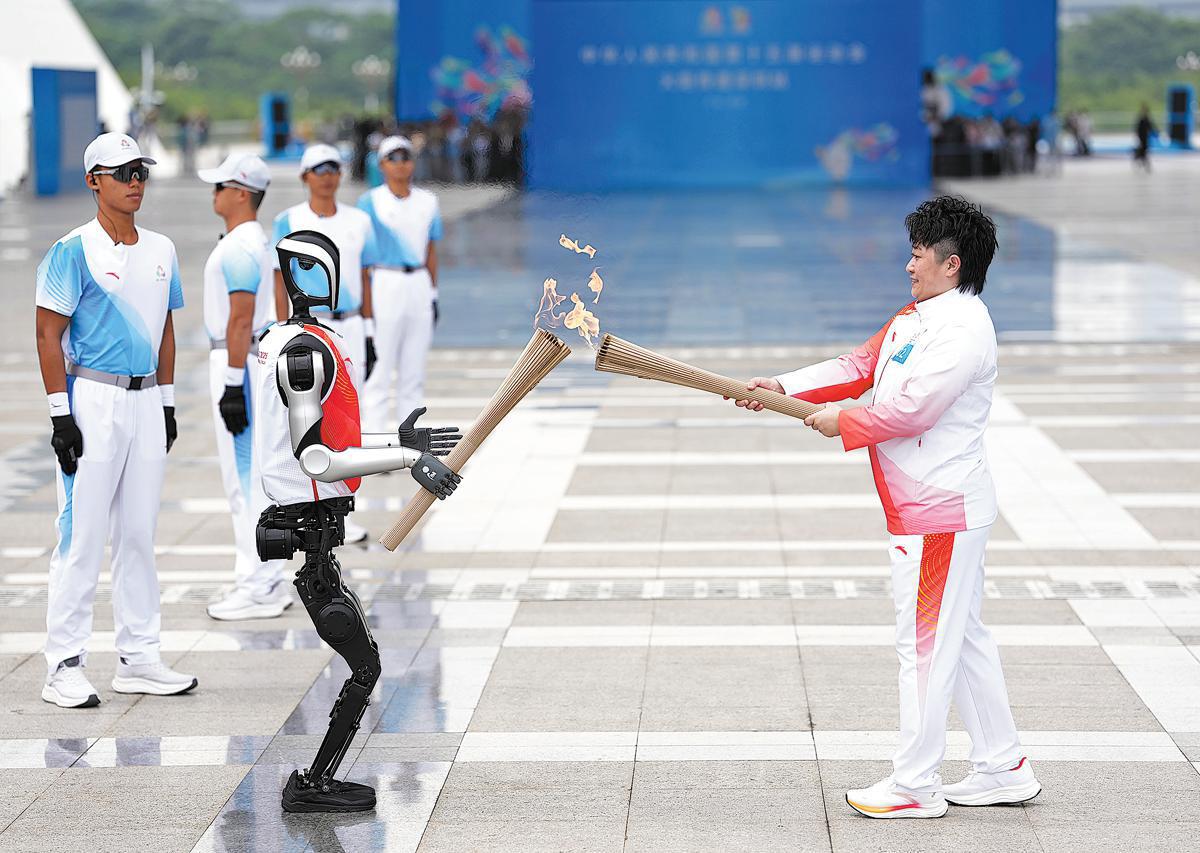
With less than a week left before the 15th National Games kick off on Nov 9, thousands of athletes from across China have arrived in the Greater Bay Area.
As the games are being co-hosted by Guangdong province and the Hong Kong and Macao special administrative regions, it is particularly tough for athletes from the northern region, which is experiencing lower temperatures, in some places even snowfall. Apart from the challenge of performing well, athletes from the northern region are also learning to adjust to the relatively higher temperatures in the south.
Thus, for many athletes, the overnight relocation from colder to warmer climes is one of the unique characteristics of the 15th National Games.
It is worth mentioning here that China is one of the few countries that organizes such a multi-sport event once every four years. Teams representing different provinces, autonomous regions, municipalities and industrial sectors fight it out for the honor of their sponsors.
The upcoming National Games will be a sports gala that attracts wide attention, in which 36,000 athletes are going to compete for 585 medal events in 57 sports categories. To get a perspective, the Paris Olympics held last year drew 10,500 athletes who competed in 329 medal events representing 32 sports categories.
Of the 57 sports categories in the contention during the National Games, 34 are very much similar to those contested in the Olympic Games. The rest are mostly traditional Chinese sports such as dragon boat racing, wushu (Chinese martial arts) and shuttlecock kicking. Another unique thing about these games is that before the opening ceremony in Guangzhou, more than 70 contestants would have already been awarded gold medals in various categories. This is because there are too many events and it is just not possible for the host city or region to organize them within the two weeks of the games. Therefore, some contests will be held prior to the opening ceremony.
Inaugurated in 1959, the National Games of China were designed to promote sports in China. Prior to 1959, modern competitive sports hardly existed in the country except in a few schools and universities. For two decades after that, the National Games were the highest level of sports events in China, which was then facing political, economic and cultural sanctions imposed by Western nations. When I was young, we boys talked about and idolized only the champions of the National Games, not because they were any superior but because we were totally ignorant about global sports events and global champs.
China's opening-up in the late 1970s as well as the popularity of TV sets introduced Chinese people to European Leagues and NBA games. The country's participation in the Olympic Games and the world championships further broadened fans' horizon regarding high-level competitive sports. As Chinese players began winning more medals at Olympic events, the National Games gradually began losing its luster for local sports fans.
In fact, there have been suggestions that the National Games should be cancelled because it costs a lot of resources while few fans are following it. They argue that many other countries don't have such a multi-sport event and are still doing alright. However, the growing scale of the National Games shows that the sports authorities have wisely ignored such suggestions.
China treats the National Games as an occasion to promote non-Olympic sports among the people. Being held a year after the Olympic Games, the National Games serve as a platform for hundreds of talents to fight it out and get enlisted in preparation for the next Olympics and other world championships. In fact, China's impressive performances in the global sports arena in the past decades should largely be attributed to the talent pool that emerges during the National Games.
What's more, the National Games are probably the only important national platform for athletes engaging in traditional Chinese sports to show off their skills. Without government encouragement and support, some of these sports may eventually disappear.
May the 15th National Games be a success!
The author is former deputy editor-in-chief of China Daily.
The views don't necessarily represent those of China Daily.
If you have a specific expertise, or would like to share your thought about our stories, then send us your writings at opinion@chinadaily.com.cn, and comment@chinadaily.com.cn.

Chinese Olympic gold medalist Quan Hongchan led the Guangdong women's diving team to a championship win at the National Games on Sunday night.
It was Quan's first return to the pool after having been absent from domestic and international competitions for 183 days due to injuries.
The Olympian and social media influencer earned waves of cheers and screams from the spectators on-site when she demonstrated her special water splash disappearance technique in the swimming pool.
Quan, who was paired with Wang Weiying, came in first in women's synchronized 10m platform, beating her former teammate Chen Yuxi, who was paired with Zhang Minjie, representing Shanghai.
The teenage diving prodigy will also compete the women's synchronized 10m platform, but she will be absent from women's 10m platform individual to avoid worsening her injures.
Quan, the county's youngest athlete to have won three Olympic gold medals, became a freshman of Guangzhou-based Jinan University in September.
She won the gold medal at the Tokyo Olympics in 2021 when she made her major international competition debut at the age of 14.
Quan then defended her title in Paris Olympics in 2024 and won women's synchronized 10m platform alongside Chen Yuxi.
The National Games were jointly held by Guangdong, Hong Kong and Macao.

China's upcoming 15th National Games marked a historic milestone on Sunday, with its first cross-boundary torch relay held with great fanfare simultaneously in four cities in the Guangdong-Hong Kong-Macao Greater Bay Area.
Following the relay launch ceremony in the southern coastal city of Shenzhen, Guangdong province, the torch for the quadrennial multisport event was carried by 200 torchbearers, 50 each in Shenzhen, the provincial capital Guangzhou, the Hong Kong Special Administrative Region and the Macao SAR.
In another first, the "source flame "for the torch relay was obtained directly from the ocean floor. In early October, it was ignited using combustible ice collected from the Haima cold seep at a depth of 1,522 meters in the South China Sea.
Addressing the ceremony in Shenzhen, Governor of Guangdong Meng Fanli called the torch relay a brilliant interpretation of the Chinese sporting spirit and the Olympic spirit, and said it will undoubtedly gather tremendous momentum for advancing the cause of building a strong nation and promoting national rejuvenation.
The relay is a vivid demonstration of the institutional advantages of the "one country, two systems "policy and the achievements made in the construction of the Greater Bay Area, which will surely draw the world's attention more closely to Guangdong, to the GBA and to China, he said.
Li Jiayi, a Yueju Opera actress and winner of the Chinese Drama Plum Blossom Award, said she felt honored to be selected as a torchbearer for the Guangzhou leg of the relay. "We carry not only the flame for the National Games, but also the cultural fire passed down from generation to generation," she added.
Another torchbearer, Liu Pingyun, a professor at Guangzhou Academy of Fine Arts, said the relay showcased the region's history, culture and vitality, as torchbearers ran past landmarks in Guangzhou, including iconic buildings and scenic spots.
It also served as an opportunity to showcase the region's high-tech future, with Kuavo, the world's first 5G-A humanoid robot torchbearer, making its debut in Shenzhen.
In the Hong Kong SAR, acting chief executive Eric Chan Kwok-ki said the relay fully showcased the distinctive advantages of the Greater Bay Area, and highlighted the city's role as an international metropolis.
On Nov 9, representatives from the four cities will bring the torch flames to the Guangdong Olympic Sports Center in Guangzhou, and the flames will be merged into a single flame, which will then light the main cauldron at the opening ceremony of the games.

MACAO -- The torch relay for the Macao session of China's 15th National Games was held on Sunday morning, filling the city with festive energy and pride as the flame made its way through some of Macao's most iconic landmarks.
The relay began at the headquarters of the Macao Special Administrative Region (SAR) government. Chief Executive Sam Hou-fai lit the first torch and handed it to Li Yi, who won the women's changquan gold medal for Macao at the Hangzhou Asian Games in 2023.
Covering a total distance of about 2.6 kilometers across the Macao Peninsula, the route passed several renowned landmarks and concluded at the Ruins of St. Paul's, a UNESCO World Heritage Site, with a total of 50 torchbearers participating.
The final torchbearer Kuok Kin-hang, who won a bronze medal in the men's karate at the 14th National Games to become Macao's first-ever medalist at the Games, carried the flame up the steps in front of the Ruins of St. Paul's and lit the cauldron amid cheers.
"I feel very honored and happy to be the final torchbearer," he told Xinhua, adding that it can be an experience "remembered for a lifetime."
The torch relay for the 15th National Games was held simultaneously on Sunday in Hong Kong, Macao, Guangzhou and Shenzhen, marking the first cross-boundary torch relay in the history of the Games and the first time the torch has been carried in Hong Kong and Macao.
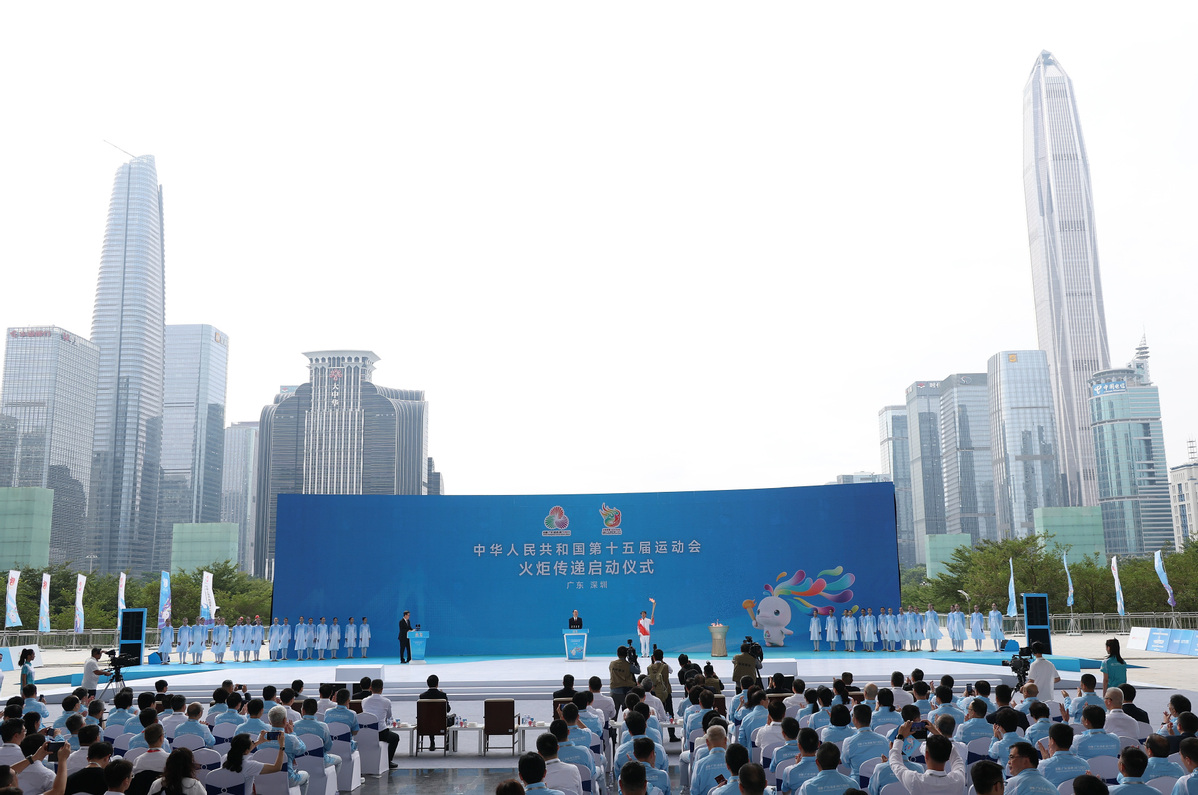
SHENZHEN -- China's National Games celebrated a milestone on Sunday as its first cross-boundary torch relay is held simultaneously in Guangdong, Hong Kong and Macao, with one week before the Games opens.
Following the launch ceremony in the southern coastal city of Shenzhen, the torch relay started in Hong Kong, Macao, Guangzhou and Shenzhen - four key cities of the Greater Bay Area.
200 torchbearers from all walks of life will carry the flame, including physicist Xue Qikun and former Olympic diving champion Yang Jinghui.
The "source flame" was extracted and ignited from combustible ice lying more than 1,500 meters beneath the surface of the South China Sea in September.
Following the relay, the torch flames from the four cities will converge in Guangzhou later on Sunday, at Guangdong Olympic Sports Center to be merged into a single flame, which will light the main cauldron at the opening ceremony of the 15th National Games on November 9.
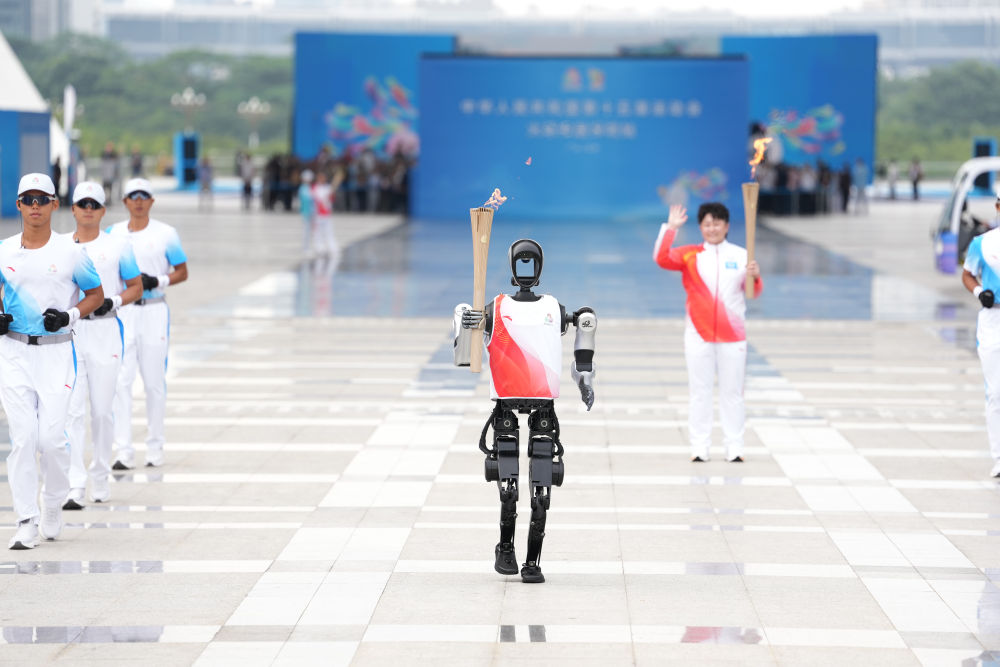
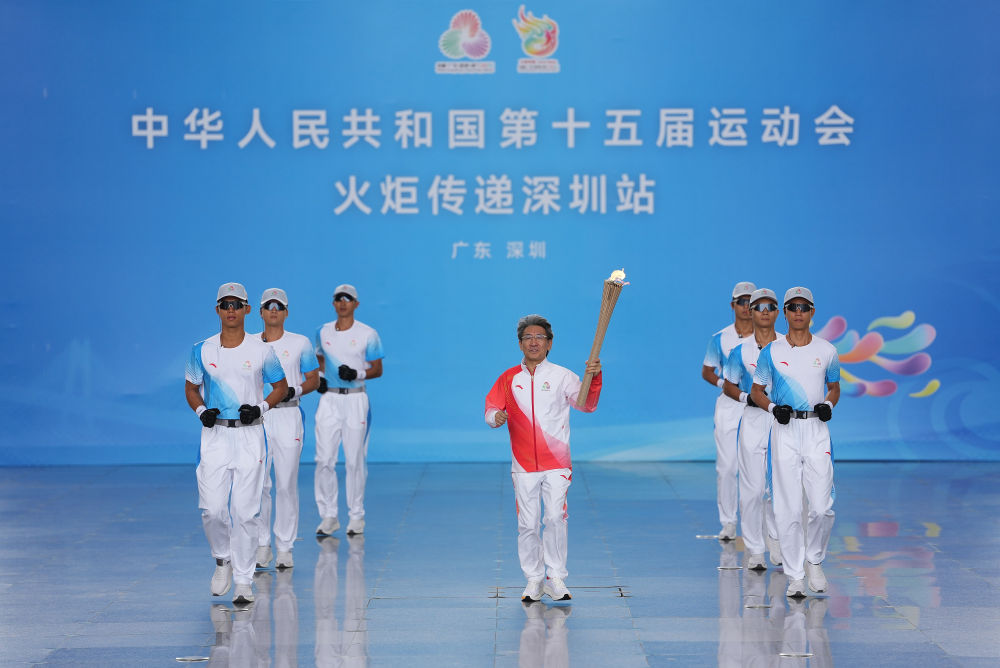
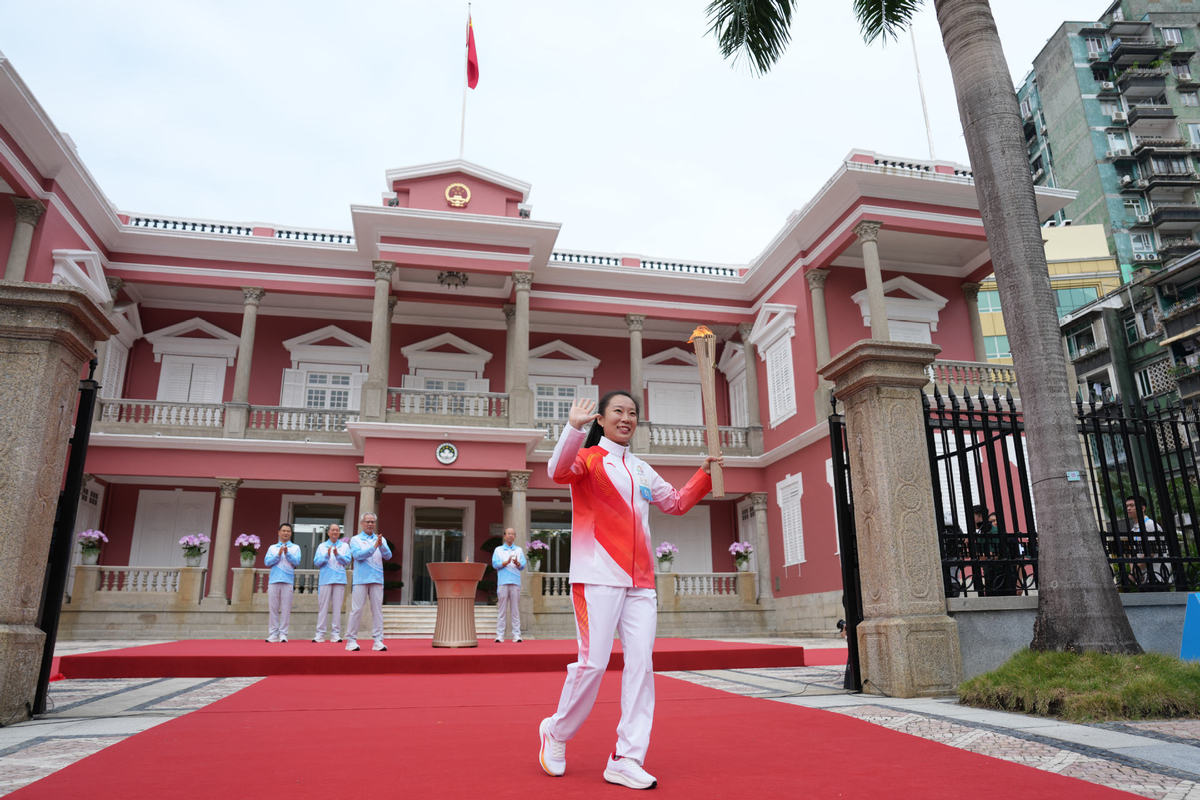

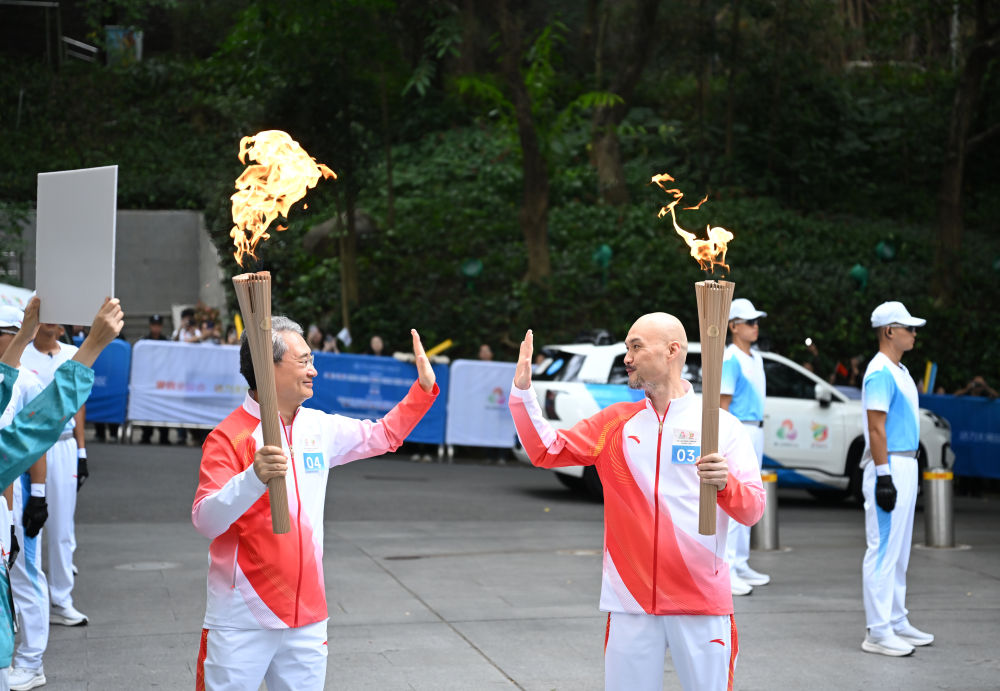

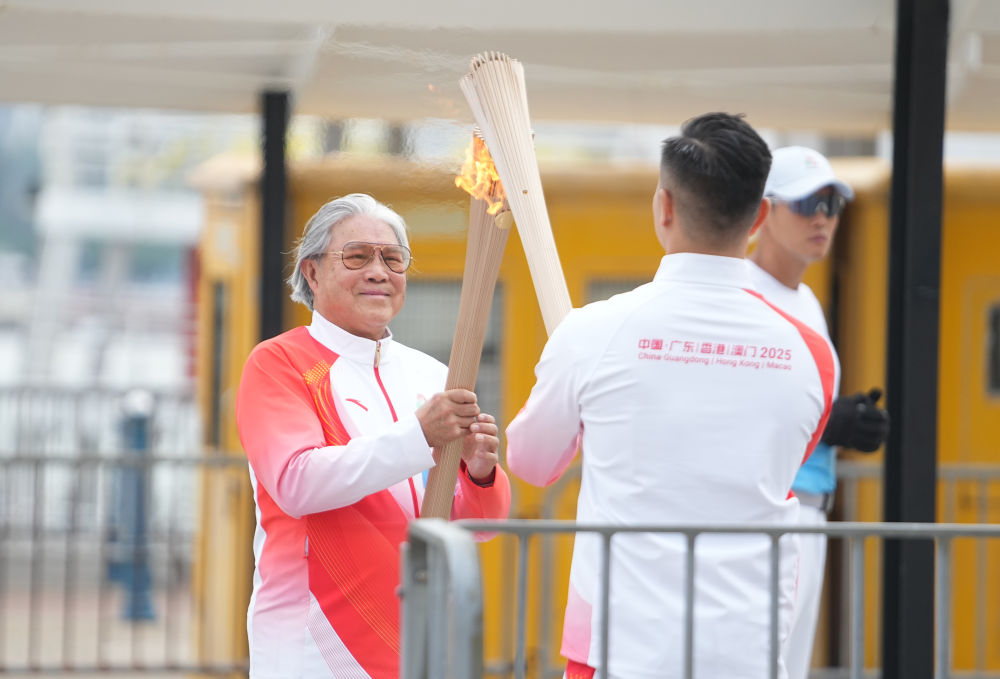

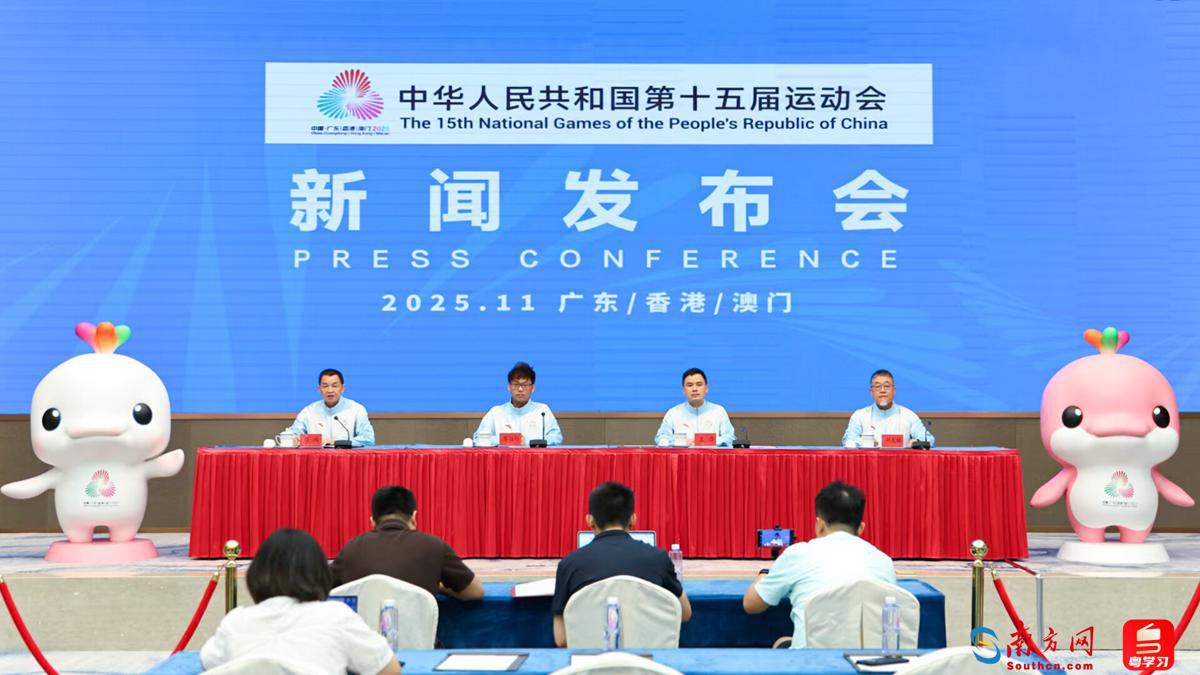
Volunteers from Guangdong province, Hong Kong, and Macao are joining forces to support the upcoming 15th National Games, an initiative that organizers say will deepen regional cooperation and youth exchange across the Greater Bay Area.
"The practice helps explore a collaborative development path for volunteer services in Guangdong," said Wang Hao, deputy director of major events and volunteer service department of the Games' Guangdong division organizing committee, during a press conference on Friday.
The Games, jointly hosted for the first time by Guangdong and the two special administrative regions, will open on Nov 9 in Guangzhou.
After a rigorous selection process, Guangdong has recruited 30,000 volunteers from 17 host cities and 99 universities, including 389 from Hong Kong, Macao, Taiwan, and overseas Chinese communities.
"Each volunteer must undergo systematic training and assessment to acquire the necessary knowledge and skills to meet the event requirements before they can begin their service," said Wang.
To encourage public participation, volunteers from transportation hubs, shopping districts, tourist sites, and cultural squares will assist visitors throughout the Games. Sectors such as ride-hailing, food delivery, and courier services are also being encouraged to offer convenient and friendly support, Wang said.
In addition, 24 professional emergency teams from across the province have conducted drills to ensure safety and smooth operations during the event.
Volunteer enthusiasm is strong beyond Guangdong. In Hong Kong, more than 30,000 people have applied, marking the largest volunteer activity in the city's history. Since its launch in February 2023, the Macao division's program has drawn broad support from the public and social organizations, with 3,500 volunteers already serving in hotels and event venues.
To strengthen coordination, the three divisions have established a regular communication mechanism, shared training materials, and exchanged instructors. "We have launched a unified cultural identity for the volunteer service theme, shared training course materials, and exchanged training instructors for mutual learning and practice, consolidating efforts to collaboratively deliver outstanding volunteer services for the Games," said Wang.
